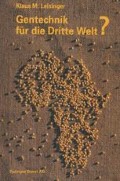Zusammenfassung
Die für die Menschen in der Dritten Welt bedeutungsvollen Nutzenpotentiale (und somit Forschungsziele) der Gentechnik unterscheiden sich im Prinzip nicht von denjenigen, die für uns in den Industrieländern wichtig sind:
Mit Hilfe der Gen- und Biotechnologie sollen die Nahrungsmittelversorgung sichergestellt, Krankheiten vermieden oder geheilt und die Umweltzerstörung aufgehalten oder wenn möglich rückgängig gemacht werden.
Access this chapter
Tax calculation will be finalised at checkout
Purchases are for personal use only
Preview
Unable to display preview. Download preview PDF.
Anmerkungen
Vgl. Leisinger K.M.: Ländliche Entwicklung und Pflanzenschutz in der Dritten Welt. IVA, Frankfurt 1989, S. 34.
Vgl. Walgate R.: Miracle or Menace? Biotechnology and the Third World. Panos-Institute, London 1990, S.62-66.
Ebenso Robertson A.I./ Sakina K.E.: A Slice of Reality from Africa. In: TIBTECH, Vol. 7, Jan.1989, S.14f.
Vgl. Messerli B.: Die natürlichen Ressourcen — Grundlagen des Lebens und Überlebens in der Dritten Welt. In: Haselbach E./ Lampel G./Meyer D./Sprumont P. (Hrsg.): Dritte Welt und Naturwissenschaften. Fribourg 1990, S. 17-52.
Vgl. Presse-und Informationsdienst zur Entwicklungszusammenarbeit mit der Dritten Welt (epi), Nr. 11, 1990, S. 17.
Siehe dazu auch Neue H.U.: Entwicklung umweltfreundlicher Reissorten. In: E+Z Entwicklung und Zusammenarbeit, Nr. 10, 1990, S. 20 f.
Siehe dazu Yilma T. et al.: Protection of Cattle Against Rinderpest With Infectious Vaccinia Virus Recombinants Expressing the HA or F Gene. In: Science, Vol. 242, 1988, S. 1058. Prof. Yilma, der für seine Arbeit den CIBA-GEIGY Tiergesundheits-Preis erhielt, geht davon aus, daß entsprechende Impfungen jährlich das Leben von 2 Millionen Rindern retten könnte.
Viele Informationen deuten darauf hin, daß die Volksrepublik China hier nicht nur erhebliche Forschungsressourcen einsetzt, sondern auch Resultate erzielt hat.
Siehe Ma Yuanling: Modern Plant Biotechnology and Structure of Rural Employment in China. ILO, Genf 1989.
Mureithi L.P./ Makau B.F.: Biotechnology and Farm Size in Kenya. ILO, Genf 1989.
Eastmond A./ Robert M.: Advanced Plant Biotechnology in Mexico: A Hope for the Neglected? ILO, Genf 1989.
Siehe Ahmed I.: The Bio-Revolution: Key to Poverty Alleviation in the Third World? In: International Labour Review, Vol. 127, No. 1, 1988, S. 63 f.
Lee H.H./Tank F.E.: The Socio-Economic Impact of Agricultural Biotechnology on Less Developed Countries. ILO 1989.
Siehe dazu Sasson A.: Biotechnologies to Match the Needs of Developing Countries: Achievements, Prospects and Implications. UNESCO, Paris 1990, S. 23 f. Ebenfalls: Biotechnologie in der Pflanzenzüchtung und Pflanzenernährung zum Nutzen der Dritten Welt. DSE (Hrsg.), Feldafing 1989, S. 103-133.
Vgl. Robertson A.I./Sakina K.E., op. cit. S. 14.
Ebenda; sowie Umbeck P. et al.: Genetically Transformed Cotton (gossypium hirsutum 1.) Plants. In: BIO/TECHNOLOGY, Vol. 5, March 1987, S. 263–266.
Siehe Leisinger K.M.: Hoffnung als Prinzip. Analysen und Thesen zum Bevölkerungswachstum. UNICEF, Zürich 1989; ebenso Ehrlich P.R., Ehrlich A.H.: The Population Explosion. Simon and Schuster, New York 1990.
Swift J.: Gullivers Reisen. Insel, Frankfurt 1974, S. 191 f.
Vgl. z.B. die Artikelserie der New York Times vom 9. bis 20.9.1990.
Vgl. z.B. Bossert F.W.: Die privaten und sozialen Kosten der Chagas-Krankheit. ILE, Rüegger, St. Gallen 1987.
Siehe Leisinger K.M.: Hoffnung als Prinzip. Op. cit. Ebenso UNFPA: Bevölkerungsbericht 1991, Bonn 1991.
Vgl. Leisinger K.M.: Health Policy for Least Developed Countries. Social Strategies, Vol. 16, Basel 1985.
Vgl. z.B.: Koechlin F.: Gentechnische Gefahren und Risikodiskussion. In: Basler Magazin, No. 45, 10.11.90, S. 15.
Siehe Seeds: Breeding Extinction. In: International Agricultural Development. Nov./Dec. 1990, S. 16-24.
Ebenso Shiva V.: Biodiversity, Biotechnology and Profit. The Need for a Peoples’ Plan to Protect Biological Diversity. In: The Ecologist, Vol. 20, No. 2. March/April 1990.
National Academy of Science, Committee on the Introduction of Genetically Engineered Organisms Into the Environment: Intro-duction of Recombinant DNA-Engineered Organisms Into the Environment. Key Issues. National Academy Press, Washington D.C. 1987, S. 12 f.
Vgl. Brill W.J.: Safety Concerns and Genetic Engeneering in Agriculture. In: Science, No. 227, 1985, S. 381. Ebenso: Catenhusen W.-M./Neumeister H. (Hrsg.): Enquête-Kommission des Deutschen Bundestages — Chancen und Risiken der Gentechnologie. Schweitzer, München 1987.
Siehe Catenhusen W.-M./Neumeister H., op. cit., S. 215 f.
Siehe für diese Diskussion: Catenhusen W.-M./Neumeister H., op. cit. Ebenso Tiedje, J.M. et al.: The Planned Introduction of Genetically Engineered Organisms. Ecological Considerations and Recommendations. In: Ecology, Vol. 70, No. 2, S. 298-315; National Academy of Sciences: Field Testing Genetically Modified Organisms: Framework for Decisions. National Academy Press, Washington D.C. 1989; Thurau, M.: Gentechnik — Wer kontrolliert die Industrie? Fischer, Frankfurt 1989.
Siehe Covello V.T. et al.: The Analysis of Actual Versus Perceived Risks, Plenum Press, New York 1983. Ebenso ders.: Risk Communication: A Review of Literature. In: Risk Abstracts, Vol. 3, No. 4, Oct. 1986, S. 171-182; Nowotny H./Eisikovik P.: Entstehung, Wahrnehmung und Umgang mit Risiken. In: Schweizerischer Wissenschaftsrat (Hrsg.): Forschungspolitische Früherkennung. Bern 1990, und die dort angegebene Literatur, S. 62-70.
Mohr H.: Biologische Erkenntnis, Stuttgart 1981.
Siehe Glewwe P.: Improving Data on Poverty in The Third World. WorldBank Working Papers. WPS 416, May 1990.
Siehe New Scientist, January 5, 1991, S. 24.
Vgl. Wambui K.: NewThreat to Cash Crops. In: Sunday Times, Nairobi, 20.11.89, S.U.
Siehe Zweifel H.: Gentechnologie gegen den Hunger? In: Der Staatsbürger, Nr. 5, 1990, S. 22–25.
Vgl. Sasson A.: Biotechnologies and Development. UNESCO, Paris 1988, S. 269–276. Ebenfalls Jacobsson S./Jamison A./Rothman H. (Hrsg.): The Biotechnological Challenge. Cambridge 1986, S. 96 f; Hobbelink H.: Bio-Industrie gegen die Hungernden, rororo, Reinbek 1989, S.46f.
Vgl. I3W Entwicklungspolitischer Dokumentations-und Pressedienst: Dokument No. 5, 28.11.89. Ebenfalls Hobbelink H.: Bio-Industrie gegen die Hungernden. Op. cit. S. 74-83.
Siehe dazu Barton HJ.: Patentiertes Leben. In: Spektrum der Wissenschaft, Mai 1991, S. 75.
Author information
Authors and Affiliations
Rights and permissions
Copyright information
© 1991 Springer Basel AG
About this chapter
Cite this chapter
Leisinger, K.M. (1991). Nutzen und Risiken der Gentechnik für die Dritte Welt. In: Gentechnik für die Dritte Welt?. Birkhäuser, Basel. https://doi.org/10.1007/978-3-0348-5607-2_3
Download citation
DOI: https://doi.org/10.1007/978-3-0348-5607-2_3
Publisher Name: Birkhäuser, Basel
Print ISBN: 978-3-0348-5608-9
Online ISBN: 978-3-0348-5607-2
eBook Packages: Springer Book Archive

